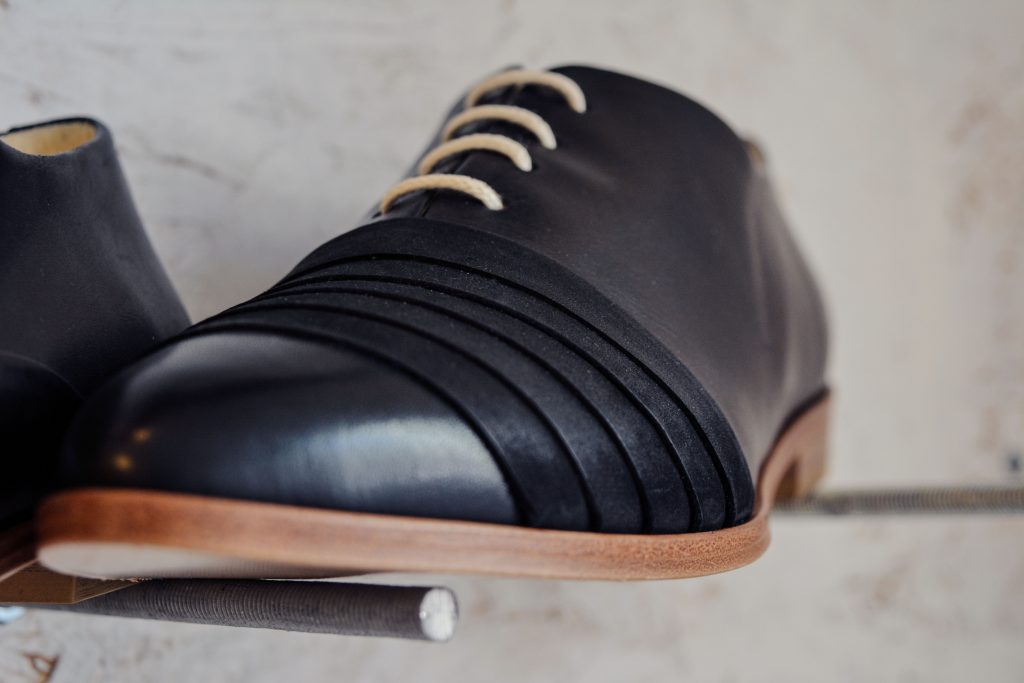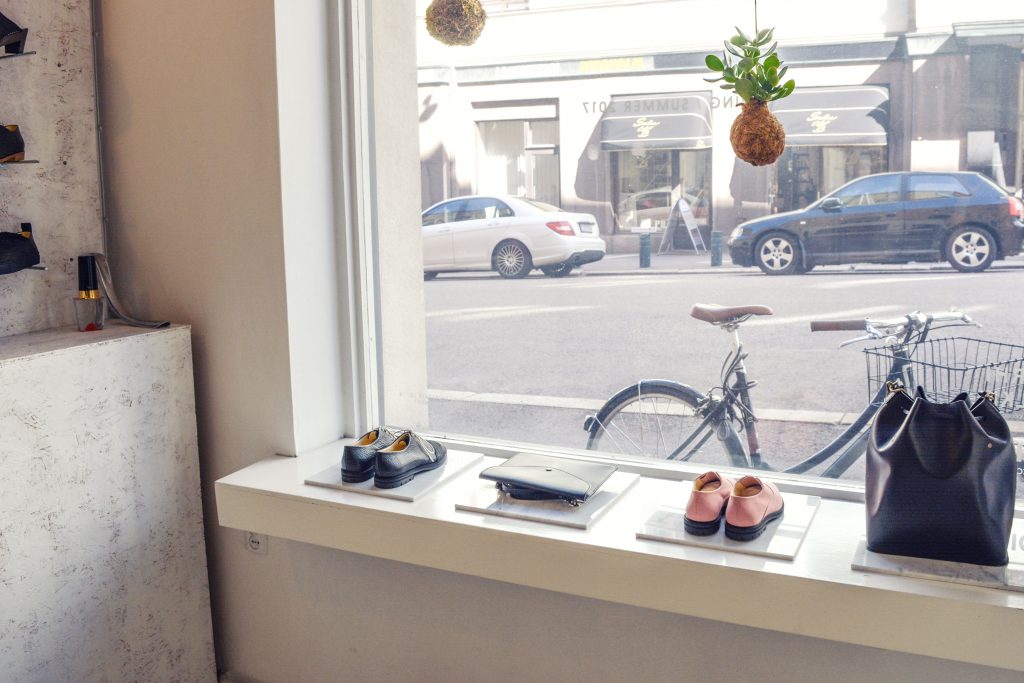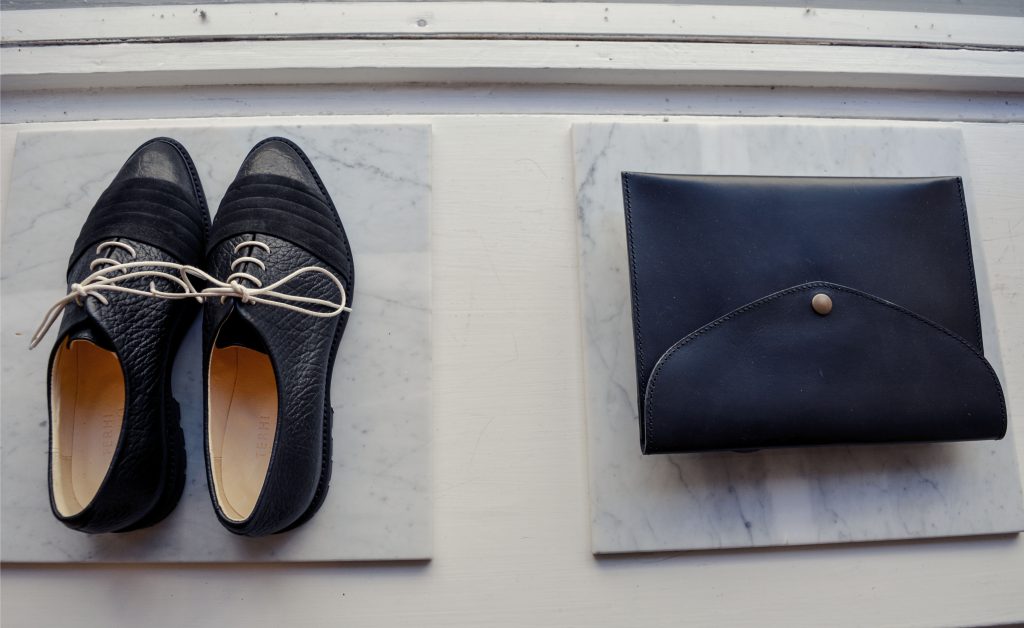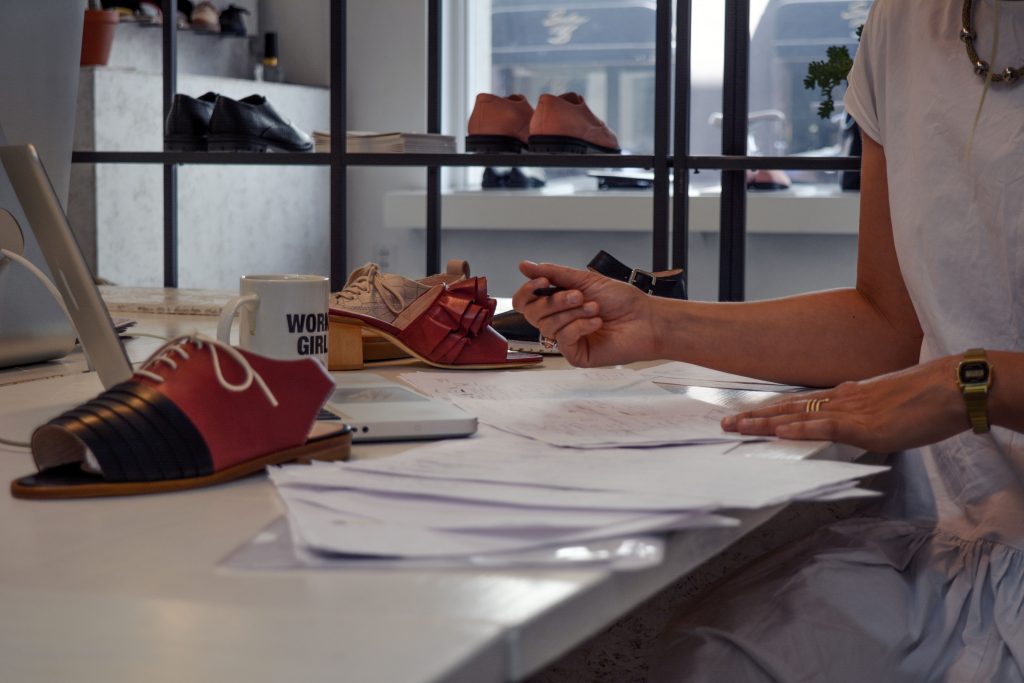Terhi Pölkki
Terhi Pölkki is the Helsinki based shoe brand of Finnish shoe designer that has garnered international acclaim. People have been charmed by its authenticity and honesty, and carefully designed, sleek heels and clogs. Sold in Anthropologie and Mr. Larkin, mentioned on Vogue Italia and Ecouterre and having won multiple awards in shoe design, Terhi has achieved plenty already and has her sights set on more growth; personally and businesswise. She has a very intimate way of designing shoes; each one is connected to a person or place of importance to her at that time of her life, making the brand a kind of journal with glimpses into her life. There’s a sense of closeness to nature, not just because of her dedication to sustainability but because the forms and colours resemble natural elements.We met up with Terhi in her studio on an unusually sunny day to discuss if Finns are prone to sustainability and how her shoes are different from mass produced, nameless products.







You say your shoes are objects with a story; where did this belief come from and how does it manifest in your making process?
It started with the fact that I was working in London for high street brands; Topshop, Urban Outfitters and Kurt Geiger. I was travelling to China a lot and the pace was really fast, we were designing like 25 styles per week. Ultimately all our shoes were numbered, all the names were numbers. When I started my brand, I wanted to move away from the idea of mass production and I wanted to know who is producing the shoes and also I wanted to use more sustainable materials and leathers. I also wanted to have the production in the European Union so that’s why I started to work in Portugal. I wanted to name all the shoes with the people or places that are really important to me. For example in the first collection there were clogs named Karin, named after Johanna who was my flatmate at that time. There is the Cat clog, which is from the Cat and Mutton in Broadway market, that was the pub we were spending the most weekends and evenings at. When the story continues now, of course the new collection is named with things that are more current in my life. That’s why I was thinking that there’s no point in designing shoes just because you want to create something new, but there needs to be purpose or there needs to be some reason why you want to bring more shoes to this world. That’s why I wanted to name them after people and places, it started to make a story, the story of my life basically.
What made you decide to start up a shoe brand?
I always wanted to, since I was 13. I think it’s more or less the same answer as the previous one, that when I was working in London I saw the mass production, we saw it in Brazil, China and India. We were doing some of the styles, and from our designs they produced more than 10,000 pairs. The most important things were the price or the quantity of the products. I decided that if I want to start a brand, I need to have some other reason also to do it. That’s why I was thinking about the sustainability behind the brand. Also I think I was at the point in my life where I had been working for a while for the other brands so I felt I had something to give for the world, I think that was the reason. But of course now if I think back, I didn’t know what I was putting myself into, but I’m pleased that I can do this.
Would you say your upbringing has had an effect in your interest in sustainability and knowing where your shoes are made?
Well my family on my mother’s side, have always been doing handcraft and my grandmother, she’s been sewing her clothes. When I was really young I got my sewing machine so I’ve been doing handcrafted things. We were always recycling our food, before they were even talking about biodegradable. I guess it’s really natural for Finnish people to be sustainable because it kind of comes from the background of the forest and the nature. I’m from the countryside, middle of Finland, so probably that has something to do with it.
Do you make any shoe samples yourself or have you done that previously?
I’m not making shoes anymore by hand. In London when I studied we had to really make the shoes, and that’s the place where I learned how to make shoes in a fine way. My design philosophy is that i’m designing for myself, that at the end of the day if I have a customer in the USA or Japan, and you start to think about what would this Japanese girl wear, you get lost in the way because I don’t know what they want. Ultimately I have to design for myself, that’s kind of my feeling. So I’m thinking about what kind of shoes I want to wear next season, and then fingers crossed that someone else wants the same shoes that I do. I feel sometimes I try to think more about the customer and then I kind of get lost, thinking too hard. I decided that it’s my brand so I need to know what I want, what the people want and trust my instincts.
Would you categorise yourself as a sustainable fashion label?
I think I do yeah, there are different labels, like people consider it when there’s local production or local sourcing. It’s a really difficult subject I think, and many people are asking about it. In general sustainability is difficult, because if you think about it there’s local production, organic, there’s so many levels. Once I know who is producing the shoes, where the materials are sourced, that they’re from Europe and whether the minimum wage is paid. I think it is sustainable but I also think that when designing shoes you really need to think about the aesthetic, not just it’s sustainable. Because then you end up doing this ‘eko sämpylä’ (colloquial Finnish term for round, brown boots), and that’s not that attractive so you really need to focus on how you want the products to look rather than just making ecological products. All the fashion brands in 2018 need to think about a sustainable point of view, it’s kind of a must.
all the fashion brands in 2018 need to think about a sustainable point of view, it’s kind of a must
Where are your materials sources and what kind of different materials do you use?
The clogs are made in Myrskylä, one hour away from Helsinki, it’s birch. The leather is vegetable tan and it comes from Kokkola and then some from Sweden. Everything is handmade there in Myrskylä. That’s my bestseller in the USA, people in America feel attracted to the clogs. The leather shoes are made in Portugal and everything is locally sourced, it’s in Madeira, it’s like a high end shoe city. You can get the soles, leather, laces, buckles, everything from the same place. There’s a lot of production there, the factories source from the local suppliers. It’s quite handy for me, when I travel there I go to the factory and find the leather and the last.
The vegetable tan leather, why did you want to use that?
I just wanted to make a difference I think, I wanted to have a purpose. I think it started when I was studying, our tutor always asked the reason for everything, you need to know why you want this kind of stitch. In Finland you can design a shoe, that’s my experience from the previous school that you design a shoe and then you produce it and then you explain that this is my idea. In London you really have to go deeper, like why did you choose this leather, why do you have the stitches this long, why is the heel this long, why not higher. So I was thinking deep, it had to be more than just okay I have a shoe, so it was kind of like a base that I built upon. Then I thought it’s important to make a difference in a sustainable way. It’s really hard to actually use the vegetan, I am in the position that I have now been thinking that I need to source the aniline leather, because there are limitations in colours and for the material. So it kind of makes my work a little bit harder at the moment. When the business grows I hope I can make a little bit more impact, because now I’m fighting with the really big brands.
Making in the EU is key to you, is it because it’s so close that you get to visit?
Yes this is one reason. Also the shipping and customs, and visits and language. I worked in London for three years for these Brazilian, Indian, Chinese factories, of course there were different levels of craftsmanship but it was quite hard, the work for them. It’s huge quantities what they expect. It’s easier for me now that I have built a relationship with a small factory, I can visit there and it’s quite straightforward, they speak good English and there’s European Union laws.
I really liked the making of the clogs video, do you want your customers to be aware of the process? To know that they’re made to last?
Well we did this video ultimately because I had an interest in Japan, and this Japan market were asking a lot of questions like where is it made, who is making these, how is it made, how can you explain it in words for Japanese people. So I decided to make a video, it’s so simple to show it and I think also the fact that clogs are quite simple products, it looks simple. In the video you can see that it’s actually quite a complicated process. It takes one year to dry the birch before you can actually start making it. There’s only one clog factory in Finland, but it’s more like a ‘paja’ workshop. There’s three people working.
Is it hard to keep the business small in a way, because you have a lot of international stockists?
It is actually, now with this collection it’s the biggest ever, and I try to think in a more commercial way because I’m going to three trade shows, New York, Paris and Copenhagen, so I’m really trying to expand. I have Anthropologie which is a huge company, they have more than 200 stores. I think especially in Anthropologie they don’t really care if it’s sustainable or not, they just care about the shoes and how they look, because it’s a big retailer. So you need to be true to yourself but at the same time you need to grow if you want to make a living with it. This year it’s been growing quite fast so it’s been a growing process for myself. People have been asking about branding and I was just doing it for myself and this year has been about trying to change the business and working methods. Working with these big companies you need to have the trademark, you need to have the inference, so I’ve been contacting the lawyers and suddenly it’s completely different than just doing some shoes. It’s difficult but exciting at the same time.
you need to be true to yourself but at the same time you need to grow

